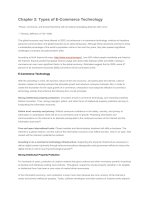Business analytics methods, models and decisions evans analytics2e ppt 12
Bạn đang xem bản rút gọn của tài liệu. Xem và tải ngay bản đầy đủ của tài liệu tại đây (5.4 MB, 63 trang )
Chapter 12
Monte Carlo Simulation and Risk
Analysis
Model Uncertainty and Risk Analysis
Many situations dictate that randomness be explicitly incorporated into our models. This is usually
done by specifying probability distributions for the appropriate uncontrollable inputs.
◦
Such models are called stochastic, or probabilistic.
Risk is the likelihood of an undesirable outcome. It can be assessed by evaluating the probability
that the outcome will occur along with the severity of the outcome.
Risk analysis seeks to examine the impact of uncertain inputs on various outputs.
Example 12.1: Incorporating Uncertainty in the Outsourcing Decision Model
Production volume is uncertain; assume normal with a mean of 1000 and standard deviation of 100.
Replace cell B12 with =ROUND(NORM.INV(RAND(), 1000, 100, true), 0)
Whenever F9 key or Formula > Calculation > Calculate Now is clicked, the value of demand will change randomly
Monte Carlo Simulation
Monte Carlo simulation is the process of generating random values for uncertain inputs in a
model, computing the output variables of interest, and repeating this process for many trials to
understand the distribution of the output results.
Monte Carlo simulation can easily be accomplished on a spreadsheet using a data table.
Example 12.2: Using Data Tables for Monte Carlo Spreadsheet Simulation
Excel file Outsourcing Decision Monte Carlo Simulation Model.
Enter the trial number (1 to 20) in column D.
Reference the cells associated with model outputs in row 3: (E3, F3, G3) (=B12, =B19, =B20)
Select the range for the data table (D3:G23)
In the Data Table dialog, enter any blank cell for the Column Input Cell.
Monte Carlo Simulation Using Analytic Solver Platform
1. Develop a spreadsheet model.
2. Determine probability distributions for uncertain
input variables.
3. Identify output variables you want to predict.
4. Choose the number of trials for the simulation.
5. Run the simulation.
6. Interpret the results.
Defining Uncertain Model Inputs
For many decision models, empirical data may be available, either in historical records or collected through
special efforts.
In other situations, historical data are not available, and we can draw upon the properties of common
probability distributions to help choose a representative distribution that has the shape that would most
reasonably represent the analyst’s understanding about the uncertain variable.
Uniform or triangular distributions are often used in the absence of data.
In Analytic Solver Platform, use custom Excel functions or the Distributions button in the ribbon.
Example 12.3: Using Analytic Solver Platform Probability Distribution
Functions
Outsourcing Decision Model
Demand (production volume) is normally distributed with a mean of
1000 and standard deviation of 100 units.
◦
◦
=PsiNormal(1000, 100) in cell B12
Use ROUND function to ensure that the result is a whole number:
=ROUND(PsiNormal(1000,100),0).
Unit cost has a triangular distribution with a minimum of $160, most
likely value of $175, and a maximum of $200.
◦
=PsiTriangular(160, 175, 200) in cell B10.
Example 12.4: Using the Distributions Button in Analytic Solver Platform
For demand, select cell B12.
Click the Distributions button in the
Analytic Solver Platform ribbon and
select the normal distribution from
the Common category.
Example 12.4 Continued
Normal distribution dialog
Change the parameters to mean = 1000, stdev = 100
Example 12.4 Continued
For unit cost, select cell B10 and select the triangular distribution
Change the parameters in the dialog
Defining Output Cells
To define a cell you wish to predict and create a distribution of output values from your model, first
select it, and then click on the Results button in the Simulation Model group in the Analytic Solver
Platform ribbon. Choose the Output option and then In Cell.
◦
◦
Analytic Solver Platform calls output cells uncertain function cells.
Uncertain function cells must be numeric.
Analytic Solver Platform adds the function PsiOutput( ) to uncertain function cell formulas.
◦
You may also add +PsiOutput( ) to any output cells manually
Example 12.5: Using the Results Button in Analytic
Solver Platform
Select cell B19
After defining the cell as an uncertain
function, the formula should read:
=B16 – B17 + PsiOutput( )
Running a Simulation
First click on the Options button in the Options group in
the Analytic Solver Platform ribbon. This displays a dialog
in which you can specify the number of trials and other
options to run the simulation (make sure the Simulation
tab is selected).
Trials per Simulation allows you to choose the number of
times that the simulation will generate random values for
the uncertain cells in the model and recalculate the entire
spreadsheet.
Random Number Seed
Analytic Solver Platform generates a stream of random
numbers from which the values of the uncertain inputs are
selected from their probability distributions.
◦
Every time you run the model, you will get slightly different results
because of sampling error.
Setting a value for Sim. Random Seed will guarantee that
the same sequence of random numbers will be used for
generating the random values for the uncertain inputs
every time the simulation is run.
Sampling Methods
Monte Carlo sampling selects random variates
independently over the entire range of possible values of
the distribution.
With Latin Hypercube sampling, the uncertain variable’s
probability distribution is divided into intervals of equal
probability and generates a value randomly within each
interval.
◦
Monte Carlo sampling is more representative of reality and should be
used if you are interested in evaluating the model performance under
various what-if scenarios.
Running a Simulation
Click the Simulate button in the Solve Action group.
When the simulation finishes, you will see a message “Simulation finished successfully” in the
lower-left corner of the Excel window.
Viewing and Analyzing Results
You may specify whether you want output charts to automatically appear after a simulation is run
by clicking the Options button in the Analytic Solver Platform ribbon, and either checking or
unchecking the box Show charts after simulation in the Charts tab.
An easy way to view results for any uncertain function is to double-click an uncertain function cell.
Example 12.6: Analyzing Simulation Results for the Outsourcing
Decision Model
Frequency distribution of cost difference
Select other options:
Percentiles, Chart Type,
Chart Options, Axis
Options,
and Markers.
Example 12.6 Continued
Set Upper Cutoff = 0 to find the probability of a negative cost difference.
New Product Development Model
Moore Pharmaceuticals spreadsheet. With
uncertain data:
1. What is the risk that the net present value
over the 5 years will not be positive?
2. What are the chances that the product will
show a cumulative net profit in the third year?
3. What cumulative profit in the fifth year are we
likely to realize with a probability of at least
0.90?
Model Assumptions
Market size: normal with mean of 2,000,000 units and standard deviation of 400,000 units
R&D costs: uniform between $600,000,000 and $800,000,000
Clinical trial costs: lognormal with mean of $150,000,000 and standard deviation $30,000,000
Annual market growth factor: triangular with minimum = 2%, maximum = 6%, and most likely =
3%
Annual market share growth rate: triangular with minimum = 15%, maximum = 25%, and most
likely = 20%
Example 12.7: Setting Up the Simulation Model for Moore
Pharmaceuticals
Market size:
◦
=PsiNormal(2000000, 400000)
R&D costs:
◦
=PsiUniform(600000000,800000000)
Clinical trial costs:
◦
=PsiLognormal(150000000, 30000000)
Annual market growth factor:
◦
=PsiTriangular(2%, 3%, 6%)
Annual market share growth rate:
◦
=PsiTriangular(15%, 20%, 25%)
Uncertain functions:
◦
Cumulative net profit each year and net present value
Simulation Results: Variables Chart
Summary of output functions and uncertain variables
◦
Customize this by checking or unchecking the boxes in the Filters pane.
Example 12.8: Risk Analysis for Moore Pharmaceuticals
1. What is the risk that the NPV over the 5 years will not be positive?









